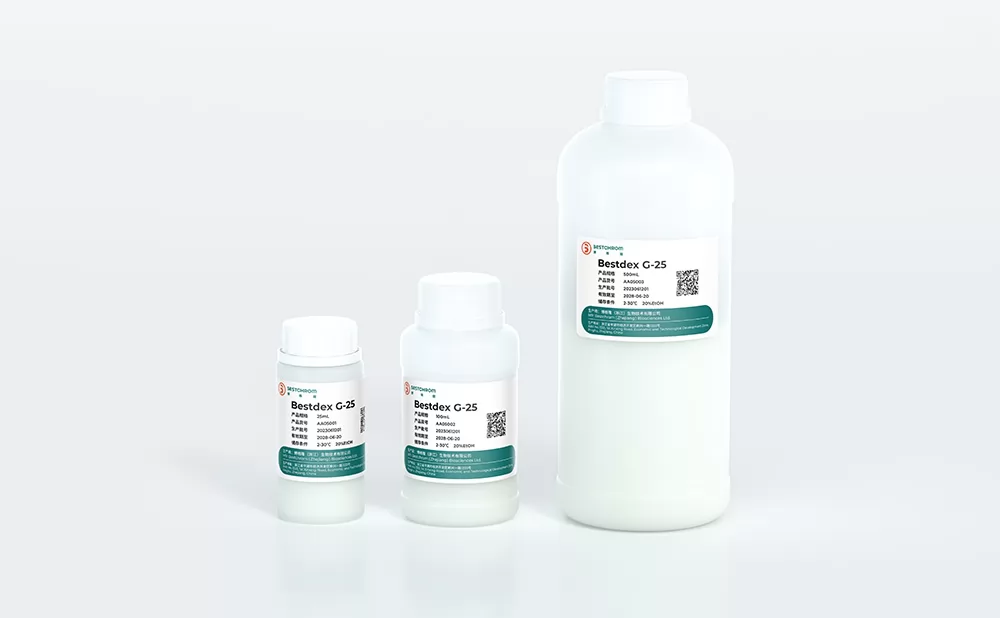Best option for desalting Bestdex G-25 resin
1. Contexts
Size exclusion chromatography(SEC), also known as gel filtration chromatography or steric exclusion chromatography, is a protein isolation technology based on the various molecular weights and shapes of bio-molecules. To put it simply, SEC acts as a screen and isolating bio-molecules based on their sizes and shapes.
SEC resin uses naturally derived polymer with porousness. When doing separation job, bio-molecules (with diameters bigger than beads pores) can only travel outside the pores along with solution, which will be eluted first due to short travel distance and high moving speed. In contrast, only a part of medium-sized bio-molecules can enter into beads pores and therefore be eluted between macro-molecules and micro-molecules. Meanwhile, micro-molecules(with diameters smaller than bead pores) can travel inside the pores for long distance and therefore be eluted at the last moment.

Fig.1 SEC resin working diagram
Application of SEC
SEC resins can primarily be applicable in the two sectors:
· Fraction isolating (desalting/buffer exchange), sample loading volume can be 30% of CV.
· Polishing (for isolation of bio-molecules in different sizes ), sample loading volume can range from 0.5% to 4%, bed height is usually bigger than 60cm.
2. Product Introduction
Bestdex G-25 SEC resins
Being SEC resins with porousness and hydrophilicity, Bestdex G-25 resins use dextran as base matrix.
According to resin bead size, Bestchrom provides four types of resin in this category. Namely, Bestdex G-25 C (Coarse) ,Bestdex G-25 M(Medium), Bestdex G-25 F(Fine), Bestdex G-25 SF (Superfine)
Technical characteristics:
|
Product |
Bestdex
G-25 C |
Bestdex
G-25 M |
Bestdex
G-25 F |
Bestdex
G-25 SF |
|
Appearance |
White to yellowish spherical powder |
|
Matrix |
Cross-linking dextran |
|
Particle size (dry) + |
100~300μm |
50~150μm |
20~80μm |
20~50μm |
|
Particle size (wet)++ |
160~500μm |
80~240μm |
30~130μm |
30~80μm |
|
Average particle size (wet)++ |
~320μm |
~140μm |
~90μm |
~50μm |
|
Max. flow velocity(cm/h)+++ |
650 |
430 |
240 |
110 |
|
Separation range |
Linear molecule |
100D~5KD |
|
Globular molecule |
1KD~5KD(10~45 amino acid) |
|
nucleotide |
<8bp |
|
Swelling ratio(mL /g dry powder) |
2.5 |
|
Volume of swelling glue per gram of dry powder |
4~6mL (water)
~4.5mL (0.5M NaCl) |
|
pH stability |
2~13 |
|
Chemical Stability |
Stable in common aqueous buffers: 0.2M NaOH,0.2M HCl,1MHAc,6M GuHCl,8M Urea, 1%SDS, 24% ethanol, 30% propanol, 30% acetonitrile |
+Particle size is normally distributed, and particles within this range account for more than 80% of the total.
++ The particle size in different solutions will be different, this data is the particle size in PBS.
+++BXK26/70, Column height 60cm, pressure 0.3MPa measured.

Fig. 2 Bestdex G-25
Advantages of Bestdex G-25 :
· Non-absorption chromatography: achieve isolation according to sizes of bio-molecules, no adsorption or desorption process, high sample yield.
· Mild operation condition: enable operation under wide condition
· Only one buffer required: only one buffer is required in the whole process, simplify operation procedures.
Application fields for Bestdex G-25
Bestdex G-25 resins achieve purification of bio-molecules via SEC mechanism. The resins are commonly used for the buffer exchange of bio-organism samples (including proteins, polysaccharide and nucleic acid), desalting and small molecule removal. It can also be used for isolation of peptide, oligonucleotides as well as the purification of antibiotics, chemical synthesized medication and natural organism. Besides, application to nanotechnology and sewage disposal is becoming increasingly commonplace.
3.Buffer exchange
Chromatography column: EzFast 5mL G-25 F x 2
Equilibration buffer : 0.2M NaHCO3, 0.5M NaCl,pH8.3
Sample loading volume : 1.9mL

Fig.3 Chromatogram of Bestdex G-25
User tips
A. Using method: Since the resin is supplied as a dry powder, it is necessary to swell and then pack the chromatography column before use.
B. Buffer selection: Aqueous buffer is generally used. The pH and conductivity of the buffer have little effect on the separation. The main consideration is the stability of the sample in the buffer.
C: Flow rate: Operate at the recommended flow velocity, the higher the column bed height, the slower the flow velocity.
D: Sample preparation: In order to prevent blocking of the column, the sample needs to be filtered by 0.45μm membrane before loading. For target molecules which are homogenous to impurities , sample loading volume should be 0.5% to 4%CV. For target which is divergent from impurities (e.g. the removal of inorganic salts from the sample), the sample loading volume should be 10% to 25% CV(not bigger than 30% CV).
4. Order Information
|
Resin |
Cat.No |
Pack size |
Resin |
Cat.No |
Pack size |
|
Bestdex G-25 M |
AG0121 |
25g |
Bestdex G-25 F |
AG0131 |
25g |
|
AG0122 |
100g |
AG0132 |
100g |
|
AG0123 |
500g |
AG0133 |
500g |
|
AG0124 |
1kg |
AG0134 |
1kg |
|
AG0125 |
5kg |
AG0135 |
5kg |
|
AG0126 |
10kg |
AG0136 |
10kg |
|
AG332115 |
25kg |
AG333115 |
25kg |
|
Pre-packed column |
Cat.No |
Pack size |
|
BC10 G-25 F |
EG002 |
30 pcs |
|
EzFast G-25 F |
EG06021 |
1×1mL |
|
EG06031 |
5×1mL |
|
EG104201 |
1×5mL |
|
EG001 |
5×5mL |
|
EzLoad 16/10 G-25 F |
EG025 |
1 pcs |
|
EzLoad 26/10 G-25 F |
EG026 |
1 pcs |
|
EzFast G-25 M |
EG05021 |
1×1mL |
|
EG05031 |
5×1mL |
|
EG05023 |
1×5mL |
|
EG05033 |
5×5mL |
|
EzLoad 50/20 G-25 M |
EG022 |
1 pcs |
|
EzLoad 50/10 G-25 M |
EG05041 |
1 pcs |
|
EzLoad 16/10 G-25 M |
EG104204 |
1 pcs |
|
EzLoad 26/10 G-25 M |
EG008 |
1 pcs |









.png)


